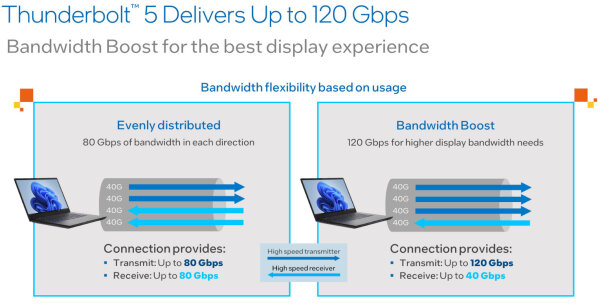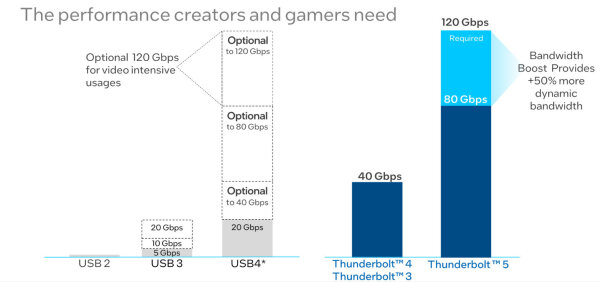Intel recently finalized the specification and development of Thunderbolt 5. So that the USB nomenclature merged with it remains confused, Thunderbolt 5 then corresponds to USB 4 version 2.0. Nothing changes in the socket and plug - the already introduced and widespread USB-C connector is still used. The minimum power delivery (PD) increases from 100W to 140W. Manufacturers can even optionally implement up to 240W (previously 140W).
While Thunderbolt 3 and 4 defined 40 GBit/s as the mandatory maximum data rate, the data rate now increases significantly with the new version after eight years. The mandatory maximum data rate is now a lush 120 Gbps. However, this is at the expense of the transmission from the opposite direction.
Thunderbolt 5 can prioritize a transmission direction in the cable for this and then send with a maximum of 120 Gbps on 3 lanes and "only" receive with 40 Gbps via one lane. However, a "symmetrical" mode on two lanes each is also possible (i.e. 80 Gbps transmit and 80 Gbps receive):

Thunderbolt 5 can prioritize lanes in one transmission direction.
For external GPUs, for example, four PCIe 4.0 lanes can also be "looped through" unfiltered by the computer, which enables a connection with a maximum of 64 GBit/s - and thus effectively corresponds to an external PCIe 4 x4 connection.
Intel sees the three main use cases for Thunderbolt 5 in high-resolution monitors, external graphics cards or very fast SSDs. Apple is also expected to use Thunderbolt 5. However, it is still highly unlikely whether there will be external GPUs under Apple Silicon in the future.
The first devices with Thunderbolt 5 are expected to appear as early as 2024. Compared to the expected USB 4 version 2.0, the only advantage is that the Thunderbolt 5 logo guarantees maximum performance. With USB 4.2, on the other hand, some of the features presented here are optional.

With USB 4, some features will remain optional in the future as well

